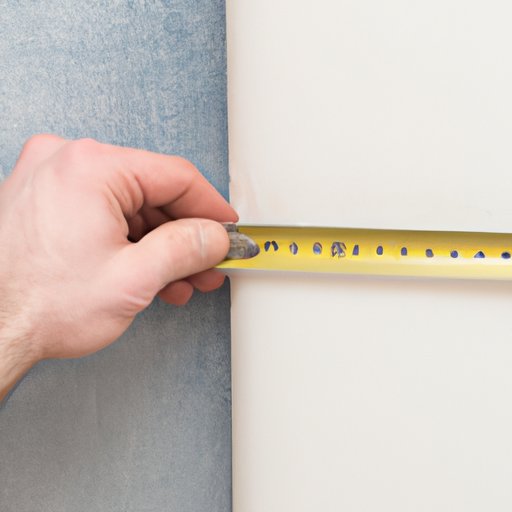
Introduction
If you’re looking to spruce up your home, adding wallpaper to your walls can be a great choice. Not only does it add color and texture to your room, but it’s also an affordable and customizable way to make your space truly your own. But before you get started, you need to know how to measure for wallpaper. In this article, we’ll explore a step-by-step guide for measuring your walls, determining how much wallpaper you need, and getting all the essential tools before hanging.
Measuring the Walls and Windows
Before you can measure for wallpaper, you need to measure your walls and windows. Start by measuring the height and width of each wall, making note of any sloping ceilings or uneven walls. When measuring windows, measure from the inside edge of the window frame.
It’s important to ensure your measurements are accurate, so be sure to measure multiple times to confirm dimensions. For uneven walls or sloping ceilings, measure both the highest and lowest points and take the average of the two for the most accurate measurement. For windows, allow for the window sill which is usually 10-15cm.
The Importance of Adding Extra Dimensions
It’s important to add extra dimensions to account for pattern matching and trimming. Pattern matching involves ensuring that the pattern on your wallpaper lines up correctly across each seam. Trimming involves cutting the wallpaper to fit around windows, corners, and other obstacles in the room.
For pattern matching, add an extra 10% or more to your dimensions to ensure you have enough wallpaper to match patterns accurately. For trimming, add an extra 5-10cm to your dimensions to allow for any adjustments needed when cutting the wallpaper.
Tips for Determining How Much Wallpaper You Need
Once you know the dimensions of your walls and windows, you can calculate how much wallpaper you need. Start by calculating the area of the room by multiplying the wall height by the wall width for each wall. Then add the areas of all the walls together to get the total area.
You also need to account for pattern repeat and waste. For a regular pattern wallpaper, add 10% to the total to account for pattern repeat. For complex patterns, add more. For waste, add an extra roll to your total for every three rolls you buy.
When choosing the wallpaper, take into account if the pattern is directional and how the whole design will fit around your room. Your lighting set up can also make a difference e.g. the wallpaper may look lighter or darker at night.
Essential Tools for Measuring and Hanging Wallpaper
Before hanging wallpaper, you need to ensure that you have all the essential tools. Some of the must-have tools include a tape measure, spirit level, seam roller, and wallpapering table. You may also need scissors or a stanley knife, a plumb line, and a wallpaper brush.
Preparing the Walls Before Measuring
It’s important to prepare the walls before measuring for wallpaper. This includes removing old wallpaper, sanding to remove any bumps or blemishes on the walls, and filling in any holes or cracks. This will ensure that the wallpaper has a smooth surface to adhere to, and will give you the best result in the end.
Calculating the Cost of Wallpaper
Finally, before buying your wallpaper, it’s important to calculate the cost of the project. This includes the cost of the wallpaper itself, any additional materials such as adhesive and paste, and the cost of tools you may need to purchase. Knowing the overall cost will allow you to budget accordingly and avoid any surprises down the road.
Conclusion
Now that you know how to measure for wallpaper, you’re ready to take on your next DIY project with confidence. Remember to measure accurately and add extra dimensions for pattern matching and trimming, and to use the essential tools needed for hanging wallpaper. By following these steps and using our tips, you’re sure to end up with a beautiful and finished product in no time.




